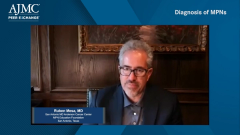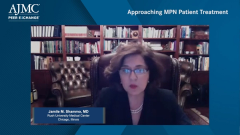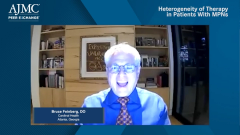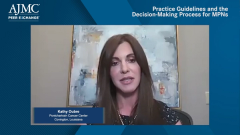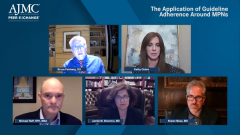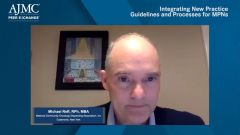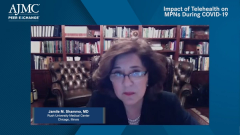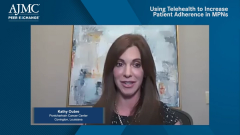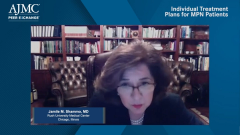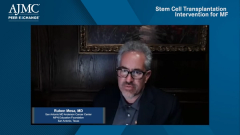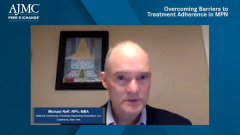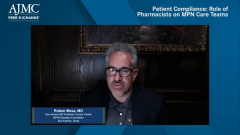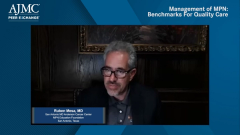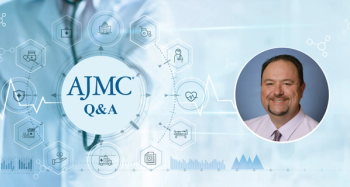
Enhancing Patient Adherence in MPN
Kathy Oubre and Michael Reff, RPh, MBA, address the lack of treatment adherence among patients with MPNs and how to overcome this with a best-practice approach.
Episodes in this series

Bruce Feinberg, DO: We talked a lot about treatment adherence, so I am curious. There has been this thought that adherence is not an issue for patients with cancer because they see the drugs as their lifeline. It may be an issue for patients with hypertension and other chronic disease states because they do not necessarily think of it as a death sentence disease. They think there is the issue that they will stop. There have been challenges to that theory about patients in oncology and adherence.
These are also drugs that do not have a significant adverse-effect profile in general. Whether it is the baby aspirin, or the Hydrea [hydroxyurea], or if it is adherence with their return office visits for their laboratory work or return office visits for their doctor visit, where do we think that the adherence is falling down? This adherence management becomes so critical.
Kathy Oubre: It starts with proper education from the beginning. Patients need to understand their illness, and they need to understand the importance of that laboratory test schedule. They need to understand the appointments and the importance of phlebotomy if that is what we are doing, or taking the baby aspirin and keeping those regular visits. They need to understand because, as Ruben said earlier, they are often the most well-looking people in your whole clinic.
They often think of themselves that way too, so they may not take their condition as seriously as others because they do not have to come to our clinic every week for a treatment. In the beginning, it is important to educate them about their disease state. To someone else’s point earlier, we also need to address it from a health literacy perspective because some of our patients are actually functionally illiterate. When we developed treatment education a long time ago, we thought that we did a great job of it, and then we reevaluated it. A consulting firm that we had brought in said, “It is at the 9th- or 10th-grade level, so you are missing a whole subset of the population.”
We then turned around and redid it all. After having that outside set of eyes, we now we have 2 sets of education. It is also important to work with those patients. Do they have access to therapeutic phlebotomy? Jamile brought that up earlier. Sometimes finding a place for a patient to go to have that done can be a challenge. You then sometimes have the working sick. We had a patient who worked as a truck driver, so you then have to bring in your care-management team, and they are trying to work to find him places where he can get phlebotomy while he is still trying to work.
We said this earlier, and Mike said it: you have to have that whole medically integrated team that understands the importance of why our patients see us. Past that, they need to start on those therapies or start on the appointments, and you have those reminders built into your EMR [electronic medical record]. Once you do the lift in the beginning on operationalizing adherence, whatever that needs to look like, it flows pretty easily, but it is a lift in the beginning. If you have buy-in from the team, if the patients and caregivers need help, it seems to enhance the whole experience for the patient.
We need to be mindful that, when we get to the Jakafi [ruxolitinib] drug and things like that, we need to make sure that our patients can afford them. If they cannot afford them, then there is nothing to monitor from an adherence standpoint. There is nothing worse than a physician writing a prescription for a patient who goes off to a specialty pharmacy, and it is then out of our hands. A couple of weeks later, we then find out that they never started because they could not afford it, or there were some other barriers that stopped access to care. We need to be mindful of that. Just because we write that prescription, our job is not done.
Bruce Feinberg, DO: A quality program does not end with the prescription being written.
Kathy Oubre: No, not at all. Even if we send that prescription out, it is our job to stay on top of that. Where it is within that specialty pharmacy? Has it been shipped? What are those barriers? Is there a prior authorization issue? Oral adherence starts before the prescription hits that patient’s home. Once that prescription hits that patient’s home, we are calling them the day of, usually 24 hours after, to ask “Did you take it? How are you doing? Are you able to swallow it? Are there any issues?” We then put them on a regular cadence after that. That is usually weekly for a while until the patient feels comfortable, and we feel comfortable that everything is humming and working well.
Transcript edited for clarity.
Newsletter
Stay ahead of policy, cost, and value—subscribe to AJMC for expert insights at the intersection of clinical care and health economics.

